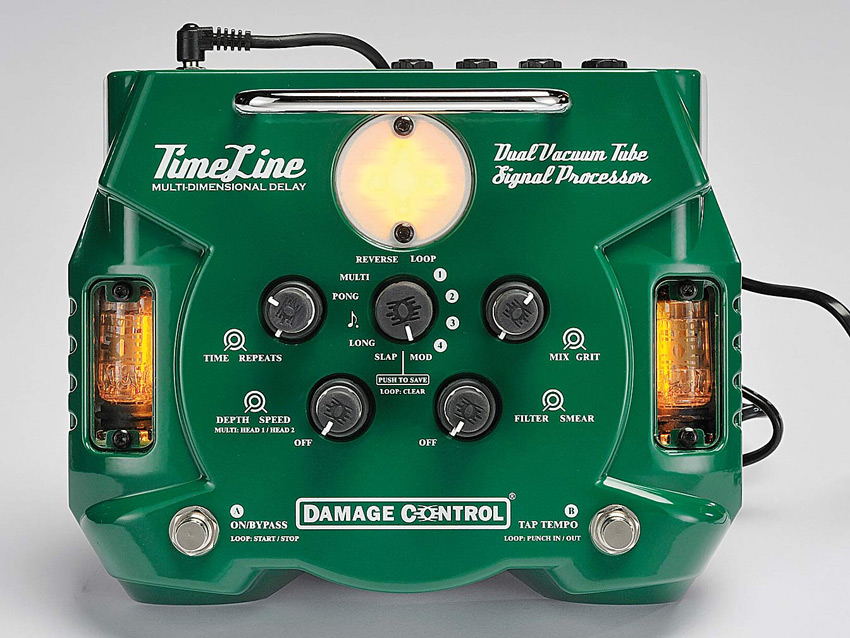MusicRadar Verdict
If delay's your thang you have to try this one. The modulation and looper effects are the icing on the cake.
Pros
- +
Generous features. Great sounds. Intuitive interface. MIDI access
Cons
- -
Apart from the price, nothing!
MusicRadar's got your back
Damage Control's pedals are like no other stompboxes you've ever seen, sporting dual 12AX7 valves, MIDI control and a huge range of features. The Time Line is one of two new delay/echo offerings to be unveiled by Damage Control, who recently formed a strategic partnership with Peavey.
This 'multi-dimensional delay' promises 96KHz true stereo signal processing and a whole host of delay-based effects.The whole unit is constructed to the highest standards, and feels pretty indestructible. Even the dual concentric knobs are solid and chunky, unlike the fiddly little controls we've seen elsewhere.
In the mode
The main focus of the control panel is the 12-position mode selector. There are seven delay modes, looper mode and four preset banks, each containing two memory slots for your own sounds.
In standard use, you have instant control over the delay time and repeats, the modulation depth and speed, filter shape and 'smear' (smooths the sharp attacks), dry/ wet mix and grit (which adds distortion to the delays). Quite a bit more control than the average delay pedal.
Round the back are stereo inputs and outputs as well as MIDI in/ out. Power is via an AC adaptor that is included.
Effect options
Of the main delay effects, 'slap', 'long' and 'reverse' are self-explanatory, and you can tap in tempos with the second footswitch. The tap tempo facility is useful with the 'dotted eighth' setting, which automatically sets the delay time to three-quarters of the tempo you tap.
'Pong' bounces the delays between the left and right outputs, while 'multi' simulates a tape delay unit. In this mode, the modulation speed/ depth controls are used to adjust the two movable tape heads.
In 'mod' mode, the range of delay times available (normally 250ms-2.5s) is greatly reduced, covering just 1ms-25ms. This is how numerous modulation and EQ effects are created, and the Time Line manual has some sample settings for comb filtering, pseudo-Leslie sounds, flanging and chorus.
In 'loop' mode the controls work differently, enabling you to set independent levels and stereo panning for the initial loop and subsequent overdubs. For nailing the timing, there's a click function with four samples (sticks, cowbell, claves and hi-hat).
The central mode switch doubles as a pushbutton. Hit it once to erase your overdubs and twice to erase overdubs and initial loop.
Strum tempo
Speaking of playing in time, a close relation of tap tempo is the strum tempo function. By holding down the tap tempo footswitch, you can then use crisply defined chord strums or staccato single notes to set the delay tempo. Perfect for those of us with dodgy brain-to-foot co-ordination!
Saving your own sounds to the preset banks is a doddle, requiring just a couple of quick twiddles. The presets are then accessed in pairs: you use the mode selector to select banks one to four, and then the two footswitches to toggle between preset A and preset B within that bank (or bypass the pedal completely).
Sounds
Here are a series of soundclips that illustrate some of the Time Line's modes:
Pong:
Multi:
Reverse:
Mod:
Slap:
You could easily lose a whole weekend playing around with the Time Line. Even just playing through the generous selection of suggested settings in the user manual, we found ourselves being thoroughly inspired by the musical possibilities.
It's not just that the quality of effect sounds is so high - we've come to expect that from Damage Control - but also the design of the unit, putting so many control options within easy reach.
Not surprisingly, the basic delay sounds cover just about every musical demand that you could imagine, from jittery rockabilly slapback right up to fat, modulated multi-tap delays that put a big beautiful halo around your solos.
The grit control makes for some nice dub-style echoes, while the smear control adds a rich 3D width to complex patterns in multi mode.
The range of possibilities available in mod mode is what really makes the Time Line special. We took the suggested setting in the manual as a starting point and nailed some quite beautiful chorus tones, easily comparable to some of the best chorus pedals we've reviewed.
In addition to the huge range of options and fantastic sound quality, the Time Line is easy to use and will handle just about any kind of delay/echo job. It will also do a decent range of modulation sounds.
The only tricky bit is the price. Plenty of people would hesitate to spend this much on their entire pedalboard, never mind a single stompbox, but then this isn't just any old stompbox. It's expensive, but after a lost weekend with the Time Line, the price starts to seem very reasonable indeed.
“Built from the same sacred stash of NOS silicon transistors and germanium diodes, giving it the soul – and snarl – of the original”: An octave-fuzz cult classic returns as Jam Pedals resurrects the Octaurus
What’s the buzz? Meet Yellowjacket, Cherry Audio's recreation of EDP’s trend-setting Wasp from 1978
“A fabulous trip through all eight songs by 24 wonderful artists and remixers... way beyond anything I could have hoped for”: Robert Smith announces new Cure remix album










